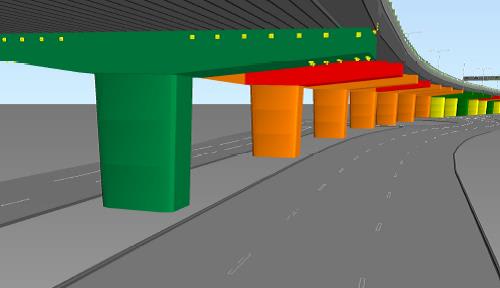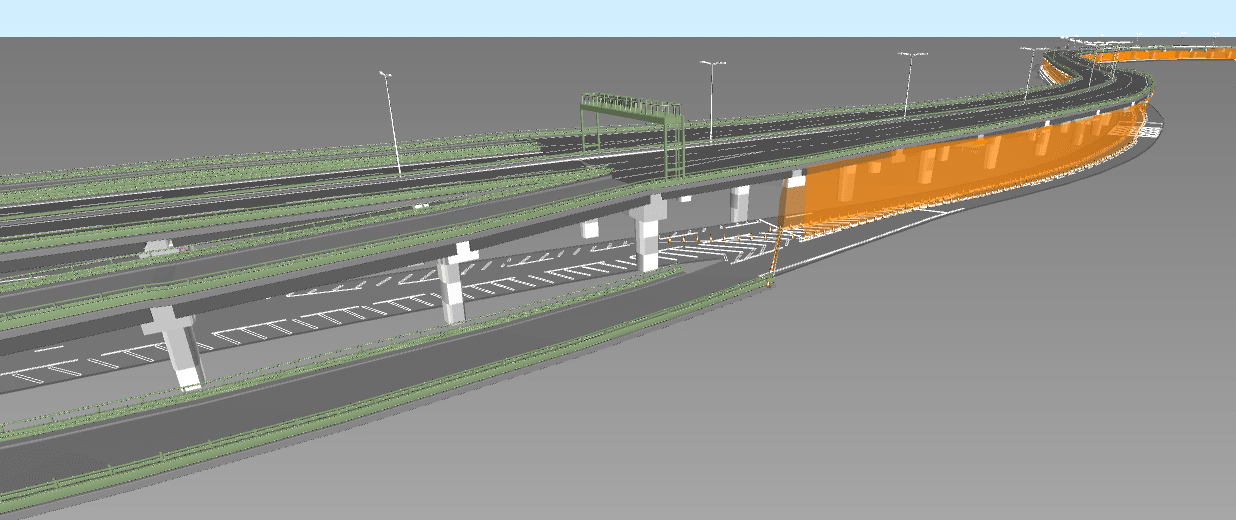- Client: Connect Plus
- Lead Contractor: Osborne
The elevated section of motorway between Junctions 1 and 3 of the M4 in west London includes 126 reinforced concrete piers which support the elevated deck. Designer Atkins utilised BIM to develop a strengthening and management strategy on the £24m project, which was awarded to contractor Osborne, working through the Connect Plus PFI consortium.
The initial stage of the project involved carrying out structural assessment of the viaduct, followed by creating a strengthening and rehabilitation design and finally planning for future maintenance and strategic intervention.
Chris Brock, group engineer at Atkins, explains: “When we took over the structure we were looking to develop a strategy to manage the elevated section for the next 30 years.”
Built in 1964, the original drawings did not contain all the information that was now needed, and due to heavy usage over the past 60 years and salt ingress, some deterioration had occurred at different rates throughout the structure.
Brock says: “We saw the opportunity to gain more of an understanding of the structure by creating a 3D model. With an existing asset you are often working with incomplete information. Creating a model helps identify risk early and put in place mitigation to deal with this.”
Connect Plus – which includes Balfour Beatty, Skanska and Atkins – undertook a point cloud survey, and then incorporated much of the as-built data into the model, along with LIDAR (remote sensor) survey data to provide an accurate representation of the elevated structure. Condition reports, which remained as PDFs, were also attached to the model.

Connect Plus undertook a point cloud survey, and then incorporated much of the as-built data into the model
Chloride readings, which measured the level of salts that had penetrated into the structure, were also added to the model, which was used to interpret its levels of impact.
Brock continues: “The model was also used for clash detection [within the strengthening design]. In some sections the solution we initially designed wouldn’t have worked as we didn’t have space to fit in the new steel bars. So we had to design a new solution with smaller bars coupled together. As this was discovered early in the design process, it didn’t impact on the programme or delivery.”
Having the BIM model allowed the designer to effectively communicate the challenge of the strengthening works to Osborne. When drilling holes for the new rebar the visualisation let the contractor know what they should expect to find, and having access to the model on site on tablets allowed the contractor to better understand how adjustments could be made if needed.
The entire project has been taking place above the A4 and the model demonstrated the interaction with the dual carriageway below, which allowed for accurate scheduling of lane and road closures.

The project has been taking place above the A4 and the model demonstrated the interaction with the dual carriageway below
“The other main benefit the model gave us was in traffic management,” says Brock. “We had to access the crossheads [cantilevers] from underneath so understanding the exact process allowed us to minimise disruption below.”
The strengthening work is scheduled to complete in the next few months and Atkins is confident that it will be completed on time and under budget. “By mitigating the risks early we can make savings,” says Brock.
These savings should continue after the strengthening works complete as Atkins is passing the model to Connect Plus. Although creating a BIM model was not an original client requirement, Connect Plus has agreed to contribute to the cost of the model based on the benefit it has seen.
However, the model does not have enough information to be used for fully comprehensive ongoing maintenance, with the safety barriers modelled as a single entity, for example, something that Atkins will look to include on future projects.
Brocks concludes: “This model is still being refined. We want to build it up and make it as useful as possible. We want it to inform both what we have done and what we believe was done before. This will mean that Connect Plus can really have confidence in the structure that they are managing.
“This was a relatively early BIM project for us. If we were to do it again we would make the model even more detailed. As a long-term tool there is a benefit of having everything modelled.”
We saw the opportunity to gain more of an understanding of the structure by creating a 3D model. With an existing asset you are often working with incomplete information. Creating a model helps identify risk early and put in place mitigation to deal with this.– Chris Brock, group engineer, Atkins











